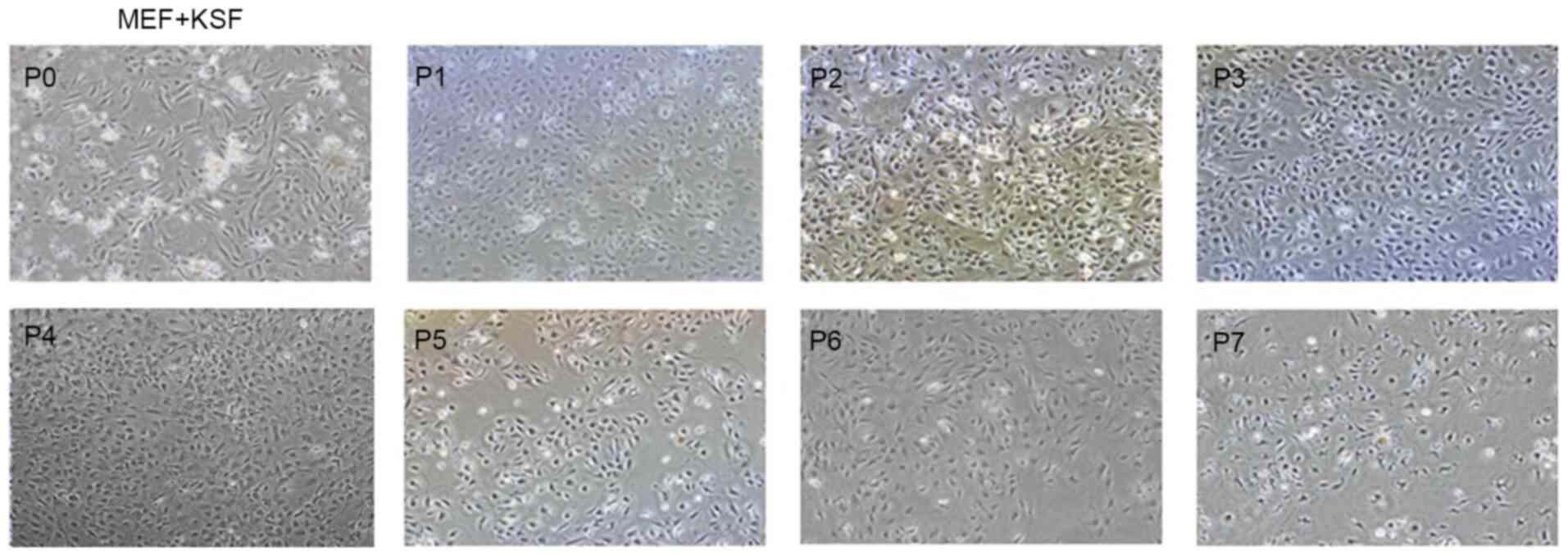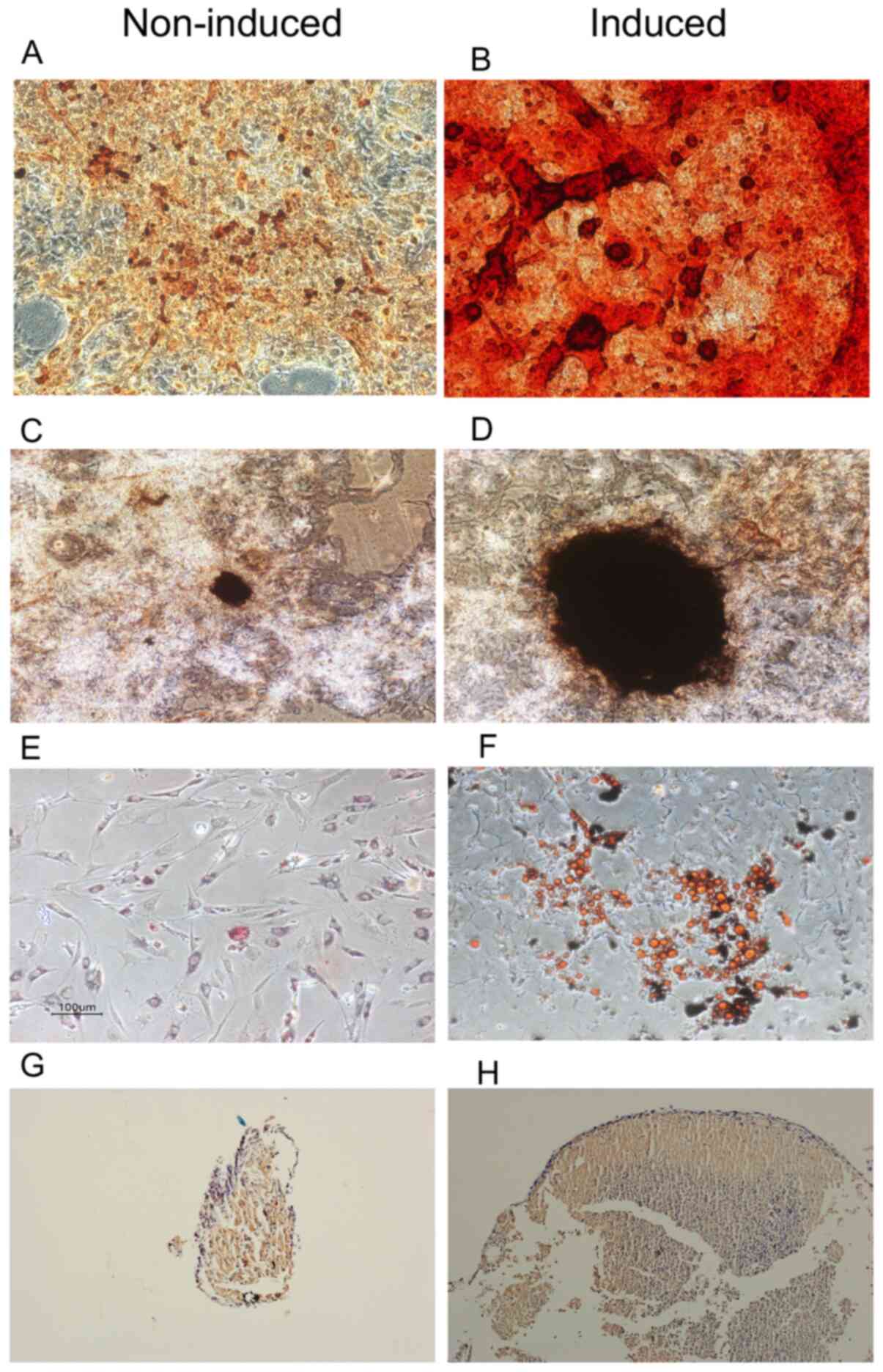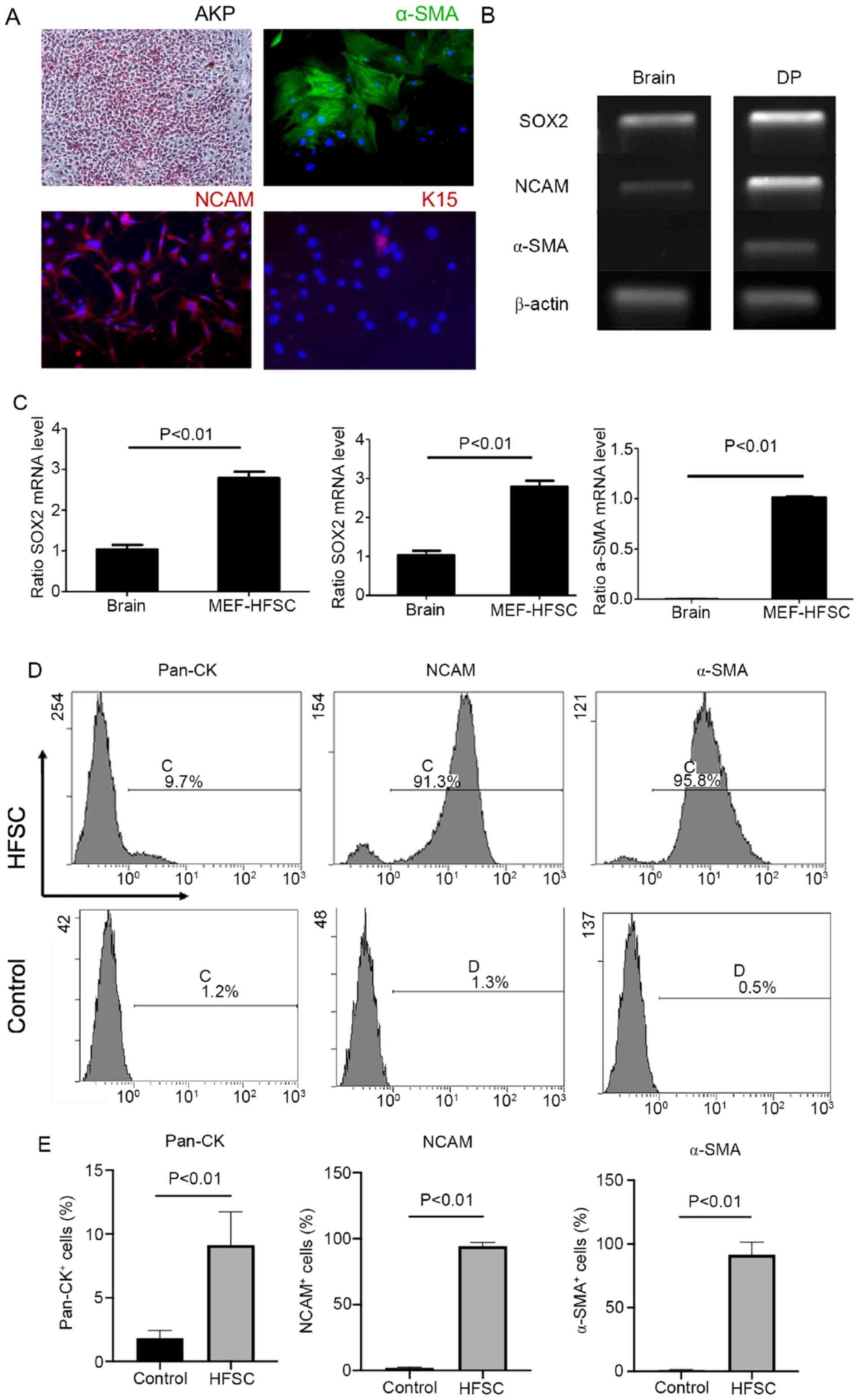|
1
|
Amoh Y, Kanoh M, Niiyama S, Hamada Y,
Kawahara K, Sato Y, Hoffman RM and Katsuoka K: Human hair follicle
pluripotent stem (hfPS) cells promote regeneration of
peripheral-nerve injury: An advantageous alternative to ES and iPS
cells. J Cell Biochem. 107:1016–1020. 2009.PubMed/NCBI View Article : Google Scholar
|
|
2
|
Carrasco E, Calvo MI, Blázquez-Castro A,
Vecchio D, Zamarrón A, de Almeida IJD, Stockert JC, Hamblin MR,
Juarranz Á and Espada J: Photoactivation of ROS production in situ
transiently activates cell proliferation in mouse skin and in the
hair follicle stem cell niche promoting hair growth and wound
healing. J Invest Dermatol. 135:2611–2622. 2015.PubMed/NCBI View Article : Google Scholar
|
|
3
|
Wang B, Liu XM, Liu ZN, Wang Y, Han X,
Lian AB, Mu Y, Jin MH and Liu JY: Human hair follicle-derived
mesenchymal stem cells: Isolation, expansion, and differentiation.
World J Stem Cells. 12:462–470. 2020.PubMed/NCBI View Article : Google Scholar
|
|
4
|
Castro AR and Logarinho E: Tissue
engineering strategies for human hair follicle regeneration: How
far from a hairy goal. Stem Cells Transl Med. 9:342–350.
2020.PubMed/NCBI View Article : Google Scholar
|
|
5
|
Li B, Hu W, Ma K, Zhang C and Fu X: Are
hair follicle stem cells promising candidates for wound healing?
Expert Opin Biol Ther. 19:119–128. 2019.PubMed/NCBI View Article : Google Scholar
|
|
6
|
Brockmann I, Ehrenpfordt J, Sturmheit T,
Brandenburger M, Kruse C, Zille M, Rose D and Boltze J:
Skin-derived stem cells for wound treatment using cultured
epidermal autografts: Clinical applications and challenges. Stem
Cells Int. 2018(4623615)2018.PubMed/NCBI View Article : Google Scholar
|
|
7
|
Bergeron L, Busuttil V and Botto JM:
Multipotentiality of skin-derived precursors: Application to the
regeneration of skin and other tissues. Int J Cosmet Sci. 42:5–15.
2020.PubMed/NCBI View Article : Google Scholar
|
|
8
|
Martínez ML, Escario E, Poblet E, Sánchez
D, Buchón FF, Izeta A and Jimenez F: Hair follicle-containing punch
grafts accelerate chronic ulcer healing: A randomized controlled
trial. J Am Acad Dermatol. 75:1007–1014. 2016.PubMed/NCBI View Article : Google Scholar
|
|
9
|
Jahoda CA, Whitehouse J, Reynolds AJ and
Hole N: Hair follicle dermal cells differentiate into adipogenic
and osteogenic lineages. Exp Dermatol. 12:849–859. 2003.PubMed/NCBI View Article : Google Scholar
|
|
10
|
Tögel F and Westenfelder C: Adult bone
marrow-derived stem cells for organ regeneration and repair. Dev
Dyn. 236:3321–3331. 2007.PubMed/NCBI View Article : Google Scholar
|
|
11
|
Conejero JA, Lee JA, Parrett BM, Terry M,
Wear-Maggitti K, Grant RT and Breitbart AS: Repair of palatal bone
defects using osteogenically differentiated fat-derived stem cells.
Plast Reconstr Surg. 117:857–863. 2006.PubMed/NCBI View Article : Google Scholar
|
|
12
|
Bueno DF, Kerkis I, Costa AM, Martins MT,
Kobayashi GS, Zucconi E, Fanganiello RD, Salles FT, Almeida AB, do
Amaral CE, et al: New source of muscle-derived stem cells with
potential for alveolar bone reconstruction in cleft lip and/or
palate patients. Tissue Eng Part A. 15:427–435. 2009.PubMed/NCBI View Article : Google Scholar
|
|
13
|
Hoogduijn MJ, Gorjup E and Genever PG:
Comparative characterization of hair follicle dermal stem cells and
bone marrow mesenchymal stem cells. Stem Cells Dev. 15:49–60.
2006.PubMed/NCBI View Article : Google Scholar
|
|
14
|
Schneider MR, Schmidt-Ullrich R and Paus
R: The hair follicle as a dynamic miniorgan. Curr Biol.
19:R132–R142. 2009.PubMed/NCBI View Article : Google Scholar
|
|
15
|
Rochat A, Kobayashi K and Barrandon Y:
Location of stem cells of human hair follicles by clonal analysis.
Cell. 76:1063–1073. 1994.PubMed/NCBI View Article : Google Scholar
|
|
16
|
Lin BJ, Lin GY, Zhu JY, Yin GQ, Huang D
and Yan YY: LncRNA-PCAT1 maintains characteristics of dermal
papilla cells and promotes hair follicle regeneration by regulating
miR-329/Wnt10b axis. Exp Cell Res. 24(112031)2020.PubMed/NCBI View Article : Google Scholar
|
|
17
|
Ohyama M: Hair follicle bulge: A
fascinating reservoir of epithelial stem cells. J Dermatol Sci.
46:81–89. 2007.PubMed/NCBI View Article : Google Scholar
|
|
18
|
Cotsarelis G: Gene expression profiling
gets to the root of human hair follicle stem cells. J Clin Invest.
116:19–22. 2006.PubMed/NCBI View
Article : Google Scholar
|
|
19
|
Moll I: Differential epithelial outgrowth
of plucked and microdissected human hair follicles in explant
culture. Arch Dermatol Res. 288:604–610. 1996.PubMed/NCBI View Article : Google Scholar
|
|
20
|
Chen L, Duan H, Xie F, Gao Z, Wu X, Chen F
and Wu W: Tetrahydroxystilbene glucoside effectively prevents
apoptosis induced hair loss. Biomed Res Int.
2018(1380146)2008.PubMed/NCBI View Article : Google Scholar
|
|
21
|
Chi W, Wu E and Morgan BA: Dermal papilla
cell number specifies hair size, shape and cycling and its
reduction causes follicular decline. Development. 140:1676–1683.
2013.PubMed/NCBI View Article : Google Scholar
|
|
22
|
Lammens J, Maréchal M, Delport H, Geris L,
Oppermann H, Vukicevic S and Luyten FP: A cell-based combination
product for the repair of large bone defects. Bone.
138(115511)2020.PubMed/NCBI View Article : Google Scholar
|
|
23
|
Vogler HW: Basic bioengineering concepts,
Concepts in bone performance, failure, and osteosynthesis. Clin
Podiatry. 2:161–189. 1985.PubMed/NCBI
|
|
24
|
Kneser U, Schaefer DJ, Polykandriotis E
and Horch RE: Tissue enginering of bone: The reconstructive
surgeon's point of view. J Cell Mol Med. 10:7–19.
2006.PubMed/NCBI View Article : Google Scholar
|
|
25
|
Li X, Yuan Z, Wei X, Li H, Zhao G, Miao J,
Wu D, Liu B, Cao S, An D, et al: Application potential of bone
marrow mesenchymal stem cell (BMSCs) based tissue-engineering for
spinal cord defect repair in rat fetuses with spina bifida aperta.
J Mater Sci Mater Med. 27(77)2016.PubMed/NCBI View Article : Google Scholar
|
|
26
|
Loukogeorgakis S and De Coppi P: Stem
cells form amniotic fluid-potential for regenerative medicine. Best
Pract Clin Obstet Gynaecol. 31:45–57. 2015.PubMed/NCBI View Article : Google Scholar
|
|
27
|
Sypecka J and Sarnowska A: Mesenchymal
cells of umbilical cord and umbilical cord blood as a source of
human oligodendrocyte progenitors. Life Sci. 139:24–29.
2015.PubMed/NCBI View Article : Google Scholar
|
|
28
|
Jin SE and Sung JH: Hair regeneration
using adipose-derived stem cells. Histol Histopathol. 31:249–256.
2016.PubMed/NCBI View Article : Google Scholar
|
|
29
|
Cheng CS, Davis BN, Madden L, Bursac N and
Truskey GA: Physiology and metabolism of tissue-engineered skeletal
muscle. Exp Biol Med (Maywood). 239:1203–1214. 2014.PubMed/NCBI View Article : Google Scholar
|
|
30
|
Tatullo M, Marrelli M, Shakesheff KM and
White LJ: Dental pulp stem cells: Function, isolation and
applications in regenerative medicine. J Tissue Eng Regen Med.
9:1205–1216. 2015.PubMed/NCBI View Article : Google Scholar
|
|
31
|
Cotsarelis G, Sun TT and Lavker RM:
Label-retaining cells reside in the bulge area of pilosebaceous
unit: Implication for follicular stem cell, hair cycle, and skin
carcinogenesis. Cell. 61:1329–1337. 1990.PubMed/NCBI View Article : Google Scholar
|
|
32
|
Taylor G, Lehrer MS, Jensen PJ, Sun TT and
Lavker RM: Involvement of follicular stem cell in forming not only
the follicle but also the epidermis. Cell. 102:451–461.
2000.PubMed/NCBI View Article : Google Scholar
|
|
33
|
Kurata S, Itami S, Terashi H and Takayasu
S: Successful transplantation of cultured human outer root sheath
cells as epithelium. Ann Plast Surg. 33:290–294. 1994.PubMed/NCBI View Article : Google Scholar
|
|
34
|
Thomson JA, Itskovitz-Eldor J, Shapiro SS,
Waknitz MA, Swiergiel JJ, Marshall VS and Jones JM: Embryonic stem
cell lines derived from human blastocysts. Science. 282:1145–1147.
1998.PubMed/NCBI View Article : Google Scholar
|
|
35
|
Hu J, Hu S, Ma Q, Wang X, Zhou Z, Zhang W,
Sun X, Zhu W, Qian H and Xu W: Immortalized mouse fetal liver
stromal cells support growth and maintenance of human embryonic
stem cells. Oncol Rep. 28:1385–1391. 2012.PubMed/NCBI View Article : Google Scholar
|
|
36
|
Chin AC, Fong WJ, Goh LT, Philp R, Oh SK
and Choo AB: Identification of proteins from feeder conditioned
medium that support human embryonic stem cells. J Biotechnol.
130:320–328. 2007.PubMed/NCBI View Article : Google Scholar
|
|
37
|
Shwartz Y, Gonzalez-Celeiro M, Chen CL,
Pasolli HA, Sheu SH, Fan SMY, Shamsi F, Assaad S, Lin ETY, Zhang B,
et al: Cell types promoting goosebumps form a niche to regulate
hair follicle stem cells. Cell. 182:578–593. 2020.PubMed/NCBI View Article : Google Scholar
|
|
38
|
Bajpai VK, Mistriotis P and Andreadis ST:
Clonal multipotency and effect of long-term in vitro expansion on
differentiation potential of human hair follicle derived
mesenchymal stem cells. Stem Cell Res. 8:74–84. 2012.PubMed/NCBI View Article : Google Scholar
|
|
39
|
Morris RJ, Liu Y, Marles L, Yang Z,
Trempus C, Li S, Lin JS, Sawicki JA and Cotsarelis G: Capturing and
profiling adult hair follicle stem cells. Nat Biotechnol.
22:411–417. 2004.PubMed/NCBI View
Article : Google Scholar
|
|
40
|
Morgan BA: The dermal papilla: An
instruction niche for epithelial stem and progenitor cells in
development and regeneration of the hair follicle. Cold Spring Harb
Perspect Med. 4(a015180)2014.PubMed/NCBI View Article : Google Scholar
|
|
41
|
McElwee KJ, Kissling S, Wenzel E, Huth A
and Hoffmann R: Cultured peribulbar dermal sheath cells can induce
hair follicle development and contribute to the dermal sheath and
dermal papilla. J Invest Dermatol. 121:1267–1275. 2003.PubMed/NCBI View Article : Google Scholar
|
|
42
|
Liu JY, Peng HF, Gopinath S, Tian J and
Andreadis ST: Derivation of functional smooth muscle cells from
multipotent human hair follicle mesenchymal stem cells. Tissue Eng
Part A. 16:2553–2564. 2010.PubMed/NCBI View Article : Google Scholar
|
|
43
|
Yu H, Kumar SM, Kossenkov AV, Showe L and
Xu X: Stem cells with neural crest characteristics derived from the
bulge region of cultured human hair follicles. J Invest Dermatol.
130:1227–1236. 2010.PubMed/NCBI View Article : Google Scholar
|
|
44
|
Boden SD: The ABCs of BMPs. Orthop Nurs.
24:49–52; quiz53-54. 2005.PubMed/NCBI View Article : Google Scholar
|
|
45
|
Lin CM, Yuan YP, Chen XC, Li HH, Cai BZ,
Liu Y, Zhang H, Li Y and Huang K: Expression of Wnt/β-catenin
signaling, stem-cell markers and proliferating cell markers in rat
whisker hair follicles. J Mol Histol. 46:233–240. 2015.PubMed/NCBI View Article : Google Scholar
|
|
46
|
Li F, Song N, Tombran-Tink J and Niyibizi
C: Pigment epithelium-derived factor enhances differentiation and
mineral deposition of human mesenchymal stem cells. Stem Cells.
12:2714–2723. 2013.PubMed/NCBI View Article : Google Scholar
|
|
47
|
Lyles JM, Amin W, Bock E and Weill CL:
Regulation of NCAM by growth factors in serum-free myotube
cultures. J Neurosci Res. 34:273–286. 1993.PubMed/NCBI View Article : Google Scholar
|
|
48
|
Seo E, Basu-Roy U, Zavadil J, Basilico C
and Mansukhani A: Distinct functions of sox2 control self-renewal
and differentiation in the osteoblast lineage. Mol Cell Biol.
22:4593–4608. 2011.PubMed/NCBI View Article : Google Scholar
|
|
49
|
O'Connor MD, Kardel MD, Iosfina I, Youssef
D, Lu M, Li MM, Vercauteren S, Nagy A and Eaves CJ: Alkaline
phosphatase-positive colony formation is a sensitive, specific, and
quantitative indicator of undifferentiated human embryonic stem
cells. Stem Cells. 5:1109–1116. 2008.PubMed/NCBI View Article : Google Scholar
|


















